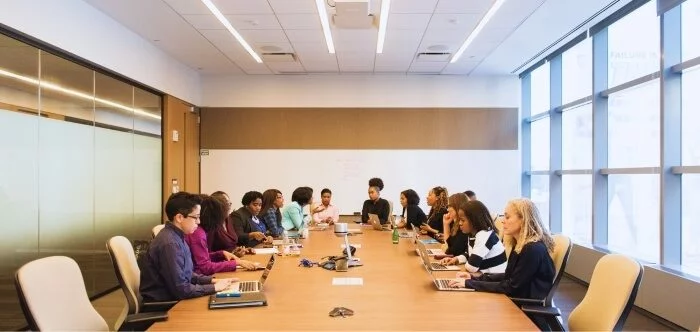Virtual conferences are becoming more and more popular in today’s fast-paced digital world. However, the question arises, “Why in-person conferences are better than virtual?” which lies in the unparalleled advantages of face-to-face interactions.
In-person meetings excel in deepening relationships, handling complex discussions, and fostering effective team-building and brainstorming sessions. They offer the essential human touch, vital non-verbal cues, and the immediacy of interaction that virtual platforms can’t replicate.
These elements are crucial for effective communication and collaboration, often missing in the digital realm. To understand the full spectrum of these benefits and why they are pivotal in the business world, continue reading our comprehensive exploration of the topic.
A Quick Overview of In-Person and Virtual Conferences
Conferences have evolved, adapting to technological advancements and changing business needs. In this digital age, the choice between in-person and virtual conferences is significant. Each mode offers distinct benefits and challenges, shaping how we connect and share knowledge.
In-person conferences offer a unique, immersive experience. They foster personal connections and spontaneous interactions, crucial for networking and relationship-building. The physical presence enables richer communication, leveraging non-verbal cues and immediate feedback.
Virtual conferences, on the other hand, provide convenience and accessibility. They allow participation from anywhere, reducing travel costs and time commitments. However, they often lack the personal touch and the dynamic energy of physical gatherings, which can limit engagement and the depth of discussions.
Conference In-Person Vs Virtual- What’s the Difference?
Navigating the world of conferences, we encounter two primary formats: in-person and virtual. Each type presents a unique set of features and environments. Understanding these differences is key to choosing the right format for your needs.
In-Person Conferences
In-person conferences provide a tangible, dynamic atmosphere. Attendees experience direct human interaction, fostering deeper personal connections and networking opportunities. The physical presence enhances engagement, allowing for spontaneous discussions and collaborative experiences.
Such conferences also offer a sensory experience, from the venue’s ambiance to interpersonal dynamics. Participants gain from non-verbal communication and immediate feedback, enriching the overall experience. However, they require travel and accommodation, potentially increasing costs and time investment.
Virtual Conferences
Virtual conferences offer convenience and accessibility, transcending geographical boundaries. Attendees can join from anywhere, making these events more inclusive and diverse. This format significantly reduces travel expenses and time, facilitating wider participation.
However, virtual events often miss the personal touch and energy of in-person interactions. Networking becomes more challenging, and attendees might experience ‘Zoom fatigue.’ The reliance on technology can also introduce challenges like connectivity issues or technical glitches.
Choosing between in-person and virtual conferences depends on your priorities, whether it’s deep connection and immersive experience or convenience and wide accessibility. Each format has its merits, shaping the landscape of modern conferencing. Understanding these differences enables better decision-making for effective and impactful event participation.
Different Types of In-Person Conferences
In-person conferences are not a one-size-fits-all affair. They vary widely, catering to different goals, industries, and audience sizes. Understanding these types allows for better planning and more successful events.
Industry Conferences
Industry conferences focus on specific sectors, bringing together professionals with common interests. They facilitate networking, knowledge sharing, and the latest industry trends. Attendees gain insights from experts, often through keynotes and panel discussions.
Academic Conferences
Academic conferences are pivotal for scholars, researchers, and educators. These gatherings are platforms for presenting research, discussing theories, and fostering academic collaboration. They play a crucial role in the advancement of scholarly work and education.
Trade Shows
Trade shows combine exhibition with conference elements, showcasing products and services. They are ideal for businesses to network, meet potential clients, and display innovations. Attendees get firsthand experience with new market offerings and industry advancements.
Workshops and Seminars
Workshops and seminars focus on skill development and learning. These smaller, more interactive formats are perfect for in-depth training and practical sessions. Participants leave with enhanced skills and new knowledge in their field.
Each type of in-person conference offers unique opportunities and experiences. Whether it’s industry insights, academic advancement, business networking, or skill enhancement, these varied formats cater to diverse needs. Knowing the differences helps in choosing the right type of conference to attend or organize, maximizing its benefits.
Different Types of Virtual Conferences
Virtual conferences have revolutionized the way we gather and exchange ideas. Adapting to digital platforms, they come in various formats, each with distinct features. Exploring these types helps in selecting the most suitable format for your objectives.
Webinars
Webinars are focused, topic-specific virtual conferences. They are typically led by an expert or panel, providing in-depth knowledge on a subject. Interactive elements like Q&A sessions enhance the learning experience for attendees.
Virtual Trade Shows
Virtual trade shows mimic their physical counterparts in a digital space. Exhibitors showcase products and services through virtual booths, offering interactive experiences. Attendees navigate the virtual floor, engaging with vendors and exploring new offerings.
Online Workshops
Online workshops are interactive and skill-oriented virtual events. These sessions are ideal for hands-on learning and practical training. Participants engage in activities and exercises, often in smaller, more focused groups.
Virtual Networking Events
Virtual networking events aim to replicate the networking opportunities of in-person conferences. They utilize breakout rooms, chat functions, and networking platforms to facilitate connections. Attendees can interact, exchange contacts, and discuss collaboration opportunities.
Virtual conferences, in their varied forms, offer flexibility and accessibility, catering to diverse needs. From in-depth learning in webinars to interactive trade shows and networking opportunities, the digital format continues to expand the horizons of conferencing. Understanding these types helps in leveraging the potential of virtual events to their fullest.
Why In-Person Conferences are Better than Virtual?
In-person conferences hold distinct advantages over virtual ones, each contributing to a more effective and engaging experience. Here’s why in-person conferences are better than virtual ones:
Deeper Human Connection and Networking
In-person conferences excel in fostering human connections. The physical presence allows for organic interactions, such as handshakes, eye contact, and body language, which are vital in building trust and rapport. Networking at these events isn’t just about exchanging business cards; it’s about shared experiences, coffee breaks, and impromptu conversations that can lead to meaningful professional relationships and collaborations. These serendipitous encounters are almost impossible to replicate in a virtual setting.
Enhanced Learning and Participation
The immersive environment of in-person conferences significantly benefits learning and engagement. Attendees are more likely to be focused and absorb information without the distractions of their regular work environment.
This setting also allows for interactive elements like workshops, live Q&As, and group discussions, which are more dynamic and engaging in person. The energy and enthusiasm in a room full of attendees can also enhance motivation and interest in the topics being discussed.
Non-Verbal Communication Cues
Much of human communication is non-verbal. In-person interactions allow attendees and speakers to pick up on these subtle cues, such as tone of voice, facial expressions, and body language.
This level of communication richness is critical for understanding, empathy, and effective interaction. It also allows speakers to gauge audience reactions and adjust their delivery accordingly, something that is difficult to replicate in a virtual environment.
Memorable Experiences and Atmosphere
In-person conferences offer a unique and memorable experience. The venue, location, and atmosphere contribute to the overall enjoyment and engagement of attendees.
Social events, such as dinners, cultural outings, and informal gatherings, add value to the conference experience, offering attendees not just knowledge, but also memorable experiences.
Reduced Technical Challenges
Virtual conferences often come with technical challenges like internet connectivity issues, software glitches, and audio-visual problems. In contrast, in-person events, while not immune to technical issues, generally offer a more controlled environment with professional audio-visual setups, ensuring a smoother and more reliable experience.
Motivation and Commitment
Attending an in-person conference often requires more commitment and investment from attendees, leading to a more motivated audience. This commitment can result in a higher level of engagement with the content and a greater appreciation for the opportunity to learn and network.
Tailored Personal Interactions
In-person conferences allow for tailored interactions. Speakers can adjust their presentations based on audience reactions, and attendees can seek out specific individuals for targeted networking opportunities. This level of personalization is challenging to achieve in a virtual format.
While virtual conferences offer advantages in terms of convenience and broader accessibility, in-person conferences provide a richer, more engaging, and effective platform for networking, learning, and experiencing, making them a preferred format for many. The choice between virtual and in-person ultimately depends on the goals of the conference and the preferences of the attendees.
In-Person Vs Virtual Conference- Which One Should You Attend?
Deciding between attending an in-person or virtual conference hinges on several factors, including your objectives, preferences, and circumstances. Here’s a breakdown to help you choose the right format:
In-Person Conferences
- Networking and Relationship Building: If your primary goal is to forge strong professional relationships or to network extensively, in-person conferences are more effective. The face-to-face interaction facilitates deeper connections and more meaningful conversations.
- Immersive Experience: For a fully immersive experience, in-person events are superior. They offer the opportunity to be present in a specific environment, away from everyday distractions, which can enhance focus and engagement.
- Hands-On Learning: If the conference includes workshops or sessions where hands-on participation is beneficial, an in-person format is more suitable. It allows for direct interaction, immediate feedback, and a more engaging learning experience.
- Travel and Logistics: Consider your willingness and ability to travel. In-person conferences often require time away from home and work, including travel and accommodation arrangements.
Virtual Conferences
- Convenience and Accessibility: If you have limited time or budget for travel, virtual conferences offer a convenient alternative. You can participate from anywhere, reducing the need for travel and accommodation expenses.
- Flexibility: Virtual events often offer the flexibility to attend only specific sessions of interest and may provide recordings for later viewing. This can be particularly beneficial if you have other commitments or are in a different time zone.
- Safety and Health Concerns: In times of health concerns, such as during a pandemic, virtual conferences provide a safe alternative to gather and learn without the risk of exposure to health hazards.
- Broad Range of Perspectives: Virtual events can attract a diverse, global audience, which can enrich discussions with a wider range of perspectives than might be physically present at an in-person event.
Combination of Both
Some conferences offer a hybrid model, combining elements of both in-person and virtual formats. This can be an ideal choice if you wish to enjoy the benefits of both, depending on the sessions and activities offered in each format.
Decision-Making Considerations
- Personal Learning Style: Consider how you learn best. Do you prefer the personal interaction and focus of in-person events, or do you find you engage well with digital content?
- Goals and Objectives: Align the conference format with your specific goals. Whether it’s networking, learning, or presenting, choose the format that best supports these objectives.
- Budget and Time Constraints: Evaluate your budget and time availability. In-person events may require a larger budget and more time away from work and home.
In summary, the choice between in-person and virtual conferences depends on your personal and professional objectives, learning preferences, budget, and the specific opportunities each format offers. Consider these factors carefully to make the most beneficial choice for your needs.
Bottom Lines
As a conclusion to our discussion, it is clear that, while virtual conferences offer convenience and reach, in-person conferences offer a number of unique advantages, answering the question, “Why are in-person conferences better than virtual conferences?”
These face-to-face events excel in fostering deep personal connections, facilitating engaging and complex discussions, and enhancing team building and brainstorming sessions. The human touch, non-verbal communication, and immediacy of interaction in in-person conferences are pivotal for effective communication and collaboration, elements often missing in virtual settings.
From richer networking opportunities and hands-on learning experiences to the unique atmosphere and tailored interactions, in-person conferences provide a more holistic and impactful experience. Thus, when choosing between in-person and virtual formats, consider these distinctive benefits and how they align with your professional goals and personal preferences.










